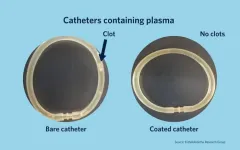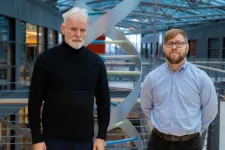(Press-News.org) Researchers at the Centre for Genomic Regulation (CRG) reveal that metabolic enzymes known for their roles in energy production and nucleotide synthesis are taking on unexpected "second jobs" within the nucleus, orchestrating critical functions like cell division and DNA repair.
The discovery, reported across two separate research papers out today in Nature Communications, not only challenges longstanding biological paradigms in cellular biology but also opens new avenues for cancer therapies, particularly against aggressive tumours like triple-negative breast cancer (TNBC).
For decades, biology textbooks have neatly compartmentalised cellular functions. Mitochondria are the powerhouses of the cell, the cytoplasm is a bustling factory floor for protein synthesis, and the nucleus a custodian of genetic information. However, Dr. Sara Sdelci and her team at the CRG have discovered that the boundaries between these cellular compartments are less defined than previously thought.
"Metabolic enzymes are moonlighting outside of their traditional neighbourhood. It’s like discovering your local baker is also a brewer in the next town over. There’s an overlap in the skillset, but they’re doing entirely different jobs for entirely different purposes," says Dr. Sdelci, lead author of both research papers.
"Surprisingly, their secondary roles in the nucleus are just as critical as their primary metabolic functions. It’s a new layer of complexity that we hadn't appreciated before,” she adds.
In one of the studies, researcher Dr. Natalia Pardo Lorente focused on the metabolic enzyme MTHFD2. Traditionally, MTHFD2 is found in the mitochondria, where it plays a key role in synthesising the building blocks of life and contributing to cell growth. Pardo Lorente's work reveals that MTHFD2 also moonlights within the nucleus, where it plays a pivotal role in ensuring proper cell division.
The study is the first to demonstrate that the nucleus relies on metabolic pathways to maintain the integrity and stability of the human genome. "Our finding fundamentally alters our understanding of how cells are organised," explains Dr. Pardo Lorente. "The nucleus isn't just a passive storage space for DNA; it has its own metabolic needs and processes."
In the second study, researchers Dr. Marta García-Cao and Dr. Lorena Espinar turned their attention to triple-negative breast cancer, the most aggressive type of breast cancer there is. The disease is responsible for around one in eight breast cancer diagnoses and amounts to roughly 200,000 new cases each year worldwide.
Usually, excessive DNA damage triggers cell death. However, TNBC has a propensity to accumulate DNA damage without consequence, making it resilient to conventional treatments. The study helps partly explain why: the metabolic enzyme IMPDH2 relocates to the nucleus of TNBC cells to assist in DNA repair processes. "IMPDH2 acts like a mechanic in the cell's nucleus, controlling the DNA damage response that would otherwise kill the cancer cell," explains García-Cao.
By experimentally manipulating IMPDH2 levels, the team found they could tip the balance. Increasing IMPDH2 within the nucleus overwhelmed the cancer cells' repair machinery, causing cells to self-destruct. "It's like overloading a sinking ship with more water — eventually, it sinks faster," says Espinar. Their approach effectively forces TNBC cells to succumb to the very DNA damage they are typically resilient to.
The study can also lead to new ways of monitoring cancer. The research on IMPDH2 also studied its interaction with PARP1, a protein already targeted by existing cancer drugs. “IMPDH2 could serve as a biomarker to predict which tumours will respond to PARP1 inhibitors," explains García-Cao.
Both studies contribute to an emerging field of therapies targeting cancer by exploiting its metabolic vulnerabilities. “Metabolic enzymes are an entirely new class of therapeutic targets for us to exploit. It paves the way for a two-pronged attack against cancer cells: disrupting their energy production while simultaneously impairing their ability to repair DNA and divide properly. Combining this strategy with conventional treatments could give cancer less room to adapt and help tackle the usual mechanisms of drug resistance,” explains Dr. Sdelci.
While the concept of enzymes having multiple roles within a cell is not entirely new, the studies show the extent and significance of these "second jobs" are only beginning to be appreciated. "This is a paradigm shift and there might be many more moonlighting metabolic enzymes yet to be found," says Dr. Pardo Lorente. "The cell is more interconnected than we thought, and that opens up exciting possibilities for science and medicine."
END
‘Moonlighting’ enzymes can lead to new cancer therapies
Metabolic enzymes have 'second jobs'. Researchers used the discovery to create a new line of attack for triple negative breast cancer.
2024-11-12
ELSE PRESS RELEASES FROM THIS DATE:
One genomic test can diagnose nearly any infection
2024-11-12
Next-generation metagenomic sequencing test developed at UCSF proves its effectiveness in quickly diagnosing almost any kind of pathogen.
A genomic test developed at UC San Francisco to rapidly detect almost any kind of pathogen – virus, bacteria, fungus or parasite – has proved successful after a decade of use.
The test has the potential to vastly improve care for neurological infections that cause diseases like meningitis and encephalitis, as well as speed up the detection of new viral pandemic threats. It uses a powerful genomic sequencing ...
Blood vessel-like coating could make medical devices safer for patients
2024-11-12
University of B.C. researchers have developed a groundbreaking coating that could make medical devices safer for millions of patients, reducing the risks associated with blood clots and dangerous bleeding.
The new material, designed to mimic the natural behavior of blood vessels, could allow for safer use of blood-contacting devices like catheters, stents, blood-oxygenation machines and dialysis machines—especially in cases where blood clots are a significant concern.
“This discovery could be a transformative step in the development of safer medical devices,” said Dr. Jayachandran Kizhakkedathu, ...
Sleep is no light matter for bees
2024-11-12
In an emerging red flag for the digital era, sleep experts have warned us to avoid screen time in bed, sounding the alarm that light emitted from phones and other electronic devices can disrupt our sleep patterns. That’s one way that science is waking up to the broad range of health and disease implications related to circadian biology and our daily sleep-wake cycles.
Now, researchers at the University of California San Diego have found that light disruption is not only a health concern for humans. A new study led by PhD candidate Ashley Kim and Professor James Nieh in the School of Biological Sciences has found that artificial light disrupts the circadian rhythms of ...
New study explores the role of BMI in disease risk
2024-11-12
New study from deCODE genetics/Amgen highlights the importance of BMI in pathogenesis of disease, suggesting that reducing BMI alone could lower the risk of several diseases.
Scientists at deCODE genetics, subsidiary of Amgen, published a study today in Nature Communications that sheds light on how Body Mass Index (BMI) influences the risk of various diseases that are comorbid with obesity. The study, which used genetic data from Iceland and the UK Biobank, looked at whether disease risk associated with BMI-related sequence variants are explained completely or partially by their effect on BMI.
The results showed that for some conditions, such as fatty liver disease, glucose intolerance, ...
Guardian, kids, or companions? What do dogs mean to us today
2024-11-12
What role do dogs play in today’s world? For many, they are more than just pets. New findings from the Department of Ethology at Eötvös Loránd University show that whether seen as friends, family members, children or guardians, these roles affect the way dogs are cared for, suggesting shifting dynamics in human-animal bonds shaped by societal trends and individual owner profiles.
In Western cultures, more and more people see their dogs as their best friends, family members or even their furry children. In fact, ...
NeuroMechFly v2: Simulating how fruit flies see, smell, and navigate
2024-11-12
All animals, large or small, have to move at an incredible precision to interact with the world. Understanding how the brain controls movement is a fundamental question in neuroscience. For larger animals, this is challenging because of the complexity of their brains and nervous systems. But the fruit fly, Drosophila melanogaster, has a smaller and therefore more easily mappable brain, allowing scientists to gain detailed insights into how its nervous system drives behavior.
To understand how the nervous system controls actions, researchers at the group of Pavan Ramdya at EPFL created a simulated reality where a virtual fly can operate ...
“Drowning” mangrove forests in Maldives signal global coastal threat
2024-11-12
Researchers have found evidence that mangrove forests – which protect tropical and subtropical coastlines – are drowning in the Maldives.
Their findings, published today (Tuesday 12 December) in Scientific Reports, indicate that rising sea level and a climate phenomenon known as the Indian Ocean Dipole have led to some Maldivian islands losing over half of their mangrove cover since 2020.
The research team, led by Northumbria University, warn that the findings have implications not only for the Maldives, but also for other island nations and coastal ecosystems around the world.
In 2020, more than a quarter of the Maldivian islands containing mangrove forests saw their trees experiencing ...
When muscles work out, they help neurons to grow, a new study shows
2024-11-12
There’s no doubt that exercise does a body good. Regular activity not only strengthens muscles but can bolster our bones, blood vessels, and immune system.
Now, MIT engineers have found that exercise can also have benefits at the level of individual neurons. They observed that when muscles contract during exercise, they release a soup of biochemical signals called myokines. In the presence of these muscle-generated signals, neurons grew four times farther compared to neurons that were not exposed to myokines. These cellular-level experiments suggest that exercise can have a significant biochemical effect on nerve growth.
Surprisingly, the researchers also ...
Smokers who switch to vaping see improved respiratory health
2024-11-12
A new paper in Nicotine and Tobacco Research, published by Oxford University Press, finds that people who switch from smoking cigarettes to vaping see improved respiratory health, but people who begin consuming electronic cigarettes while continuing to smoke regular cigarettes do not report improved respiratory symptoms.
Adults increasingly use electronic cigarettes to try to quit smoking because of the perceived reduced risk. But while vaping reduces exposure to toxic chemicals, it has been unclear whether switching from cigarettes to e-cigarettes results in a reduction of the respiratory problems—like wheezing and coughing—common in regular cigarette ...
Air pollution emerges as critical environmental risk factor for autism, emerging topic review finds
2024-11-12
Boston, Massachusetts, 12 November 2024 – Environmental exposure to air pollutants during critical developmental periods may significantly impact autism risk, according to a groundbreaking Emerging Topic review published 12 November 2024, in Brain Medicine. The study reveals how common air pollutants, including fine particulate matter and nitrogen oxides, can trigger complex biological cascades affecting brain development.
"Different kinds of neurological disorders, including autism spectrum disorder, can be associated ...
LAST 30 PRESS RELEASES:
Exposure to natural light improves metabolic health
As we age, immune cells protect the spinal cord
New expert guidance urges caution before surgery for patients with treatment-resistant constipation
Solar hydrogen can now be produced efficiently without the scarce metal platinum
Sleeping in on weekends may help boost teens’ mental health
Study: Teens use cellphones for an hour a day at school
After more than two years of war, Palestinian children are hungry, denied education and “like the living dead”
The untold story of life with Prader-Willi syndrome - according to the siblings who live it
How the parasite that ‘gave up sex’ found more hosts – and why its victory won’t last
When is it time to jump? The boiling frog problem of AI use in physics education
Twitter data reveals partisan divide in understanding why pollen season's getting worse
AI is quick but risky for updating old software
Revolutionizing biosecurity: new multi-omics framework to transform invasive species management
From ancient herb to modern medicine: new review unveils the multi-targeted healing potential of Borago officinalis
Building a global scientific community: Biological Diversity Journal announces dual recruitment of Editorial Board and Youth Editorial Board members
Microbes that break down antibiotics help protect ecosystems under drug pollution
Smart biochar that remembers pollutants offers a new way to clean water and recycle biomass
Rice genes matter more than domestication in shaping plant microbiomes
Ticking time bomb: Some farmers report as many as 70 tick encounters over a 6-month period
Turning garden and crop waste into plastics
Scientists discover ‘platypus galaxies’ in the early universe
Seeing thyroid cancer in a new light: when AI meets label-free imaging in the operating room
Neutrophil-to-lymphocyte ratio may aid risk stratification in depressive disorder
2026 Seismological Society of America Annual Meeting
AI-powered ECG analysis offers promising path for early detection of chronic obstructive pulmonary disease, says Mount Sinai researchers
GIMM uncovers flaws in lab-grown heart cells and paves the way for improved treatments
Cracking the evolutionary code of sleep
Medications could help the aging brain cope with surgery, memory impairment
Back pain linked to worse sleep years later in men over 65, according to study
CDC urges ‘shared decision-making’ on some childhood vaccines; many unclear about what that means
[Press-News.org] ‘Moonlighting’ enzymes can lead to new cancer therapiesMetabolic enzymes have 'second jobs'. Researchers used the discovery to create a new line of attack for triple negative breast cancer.








